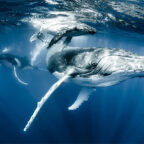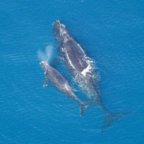
Sometimes it feels like we know all there is to know about the natural world. But when you talk to researchers in biology, ecology, geology or other science subjects, they’ll tell you what we know only scratches the surface. There’s so much more to discover. In the animal world, whale migration is a great example.
Thus far, marine biologists have never been sure why whales migrate. They hypothesized that it had something to do with where they prefer to give birth (many whales calve in warmer waters), or maybe was connected with food supplies. But whales are large enough animals that the cold waters where they tend to live should be fine for giving birth, and during migration, whales eat a lot less because they’re busy moving and not finding hunting grounds.
But there’s a new theory: Maybe whales migrate so they can shed their skin.
“I think people have not given skin molt due consideration when it comes to whales, but it is an important physiological need that could be met by migrating to warmer waters,” Robert Pitman, lead author of a new paper on the subject, and marine ecologist with Oregon State University’s Marine Mammal Institute, told Sci Tech Daily.
Traveling for thousands of miles seems like a lot of work just to get rid of old, dead skin, doesn’t it?
The evidence is pretty compelling — though it’s worth keeping in mind this is still a hypothesis. The idea was first introduced in 2011 by the paper’s authors, who were studying Antarctic killer whales at the time. Since then, they have been gathering evidence to test their theory among other whales.
What warm waters does for a whale’s skin
Like other warm-blooded animals (including humans), whales shed their skin on a constant basis. But it’s long been noticed that whales that spend a lot of time in very cold water, like the Antarctic, tend to have a yellowish discoloration to their skin. This is caused by a thick film of diatoms, microscopic creatures that some researchers say might include bacteria that’s harmful to the whales.
The diatoms collect because in that cold water, whales restrict the blood flow to their skin to save energy. But that energy savings comes at a cost to the whales’ skin, which doesn’t turn over as quickly as it should.
When whales have spent time in the the tropics, they shed their skin, and the diatoms.
The fact that the whales calve in warmer waters is just a side-effect of their travel: “Instead of whales migrating to the tropics or subtropics for calving, whales could be traveling to warm waters for skin maintenance and perhaps find it adaptive to bear their calves while they are there,” the scientists wrote in their paper published in the journal Marine Mammal Science.
To figure this out, the scientists tagged 62 killer whales over eight years. They found that the kinds of whales that like to feed in the cold waters — there’s more food there than in tropical areas — and tracked them. “Deferred skin molt could be the main driver of long‐distance migration for antarctic killer whales,” wrote the scientists. “Furthermore, we argue that for all whales that forage in polar latitudes and migrate to tropical waters, [skin molt migration] might also allow them to exploit rich prey resources in a physiologically challenging environment and maintain healthy skin.”
Other evidence to support the idea that whales migrate to molt their skin include proof that some killer whale calves were born in cold Antarctic waters, and tracking that revealed whales don’t feed much during migration. The migrating whales also moved fast — straight to the warm waters and back — with evidence that at least one whale migrated more than once in a year. Put together, these behaviors could show that the whales are feeding in the cold water, but not hunting or feeding as much in other areas, and are likely going to the warm waters for some reason other than feeding or calving.
To keep testing their hypothesis, the scientists next plan to measure the skin growth of whales that migrate and compare it to the skin growth of the whales that don’t travel. The Marine Mammal Science journal study mentioned earlier offers pictures of whales of various types with the diatom layer on their skin compared to those without.















Social Profiles